
Für eine deutsche Übersetzung dieser Seite einfach die Brandenburger Flagge anklicken
 |
Click the Brandenburg Flag for a German translation Für eine deutsche Übersetzung dieser Seite einfach die Brandenburger Flagge anklicken |


|
|
Animal AstronautsA listing of the animals that paved |
|


| Click here to return to part 1. |


November 3, 1957
   |
 |
Sputnik 2
First animal in earth orbit.
|

February 21, 1958
   |
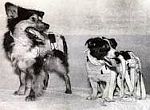 |
R-5A No. 1
An R-5 rocket launched from Kapustin Yar, U.S.S.R. carried dogs Palma and Pushok to an altitude of 400 km.
|

August 2, 1958
 Kusachka & Palma II   |
 |
R-2A No. 20
An R-2 rocket launched from Kapustin Yar, U.S.S.R. carried dogs Kusachka and Palma II to an altitude of 211 km. |

August 13, 1958
 Kusachka & Palma II   |
 |
R-2A No. 21
An R-2 rocket launched from Kapustin Yar, U.S.S.R. carried dogs Kusachka and Palma II on their second flight together to an altitude of 212 km. |

August 27, 1958
 Pyostraya & Belyanka   |
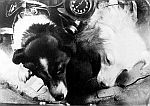 |
R-5A No. 5
An R-5 rocket launched from Kapustin Yar, U.S.S.R. carried dogs Pyostraya and Belyanka to an altitude of 450 km. |

October 31, 1958
   |
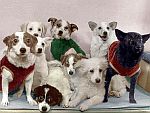 |
R-5A No. 7
An R-2 rocket launched from Kapustin Yar, U.S.S.R. carried dogs Shulba and Knopka II to an altitude of 410 km.
|

December 13, 1958
   |
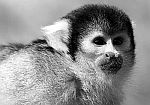 |
Jupiter AM-13 - Bioflight 1
Squirrel monkey Gordo was launched in the nose cone of a Jupiter MRBM and reached a record altitude of 500 km. Gordo was in a weightless state for
8.3 minutes, he experienced a 10g pressure in takeoff, and a 40g pressure upon reentry.
|

April 24, 1959
   |
 |
Thor-Able Re-entry 1
MIA (Mouse-in-Able) was a project to test the heat shield of the early Thor-Able ICBM. It
was also part of testing life support systems for the Man-in-Space-Soones program of the
US Air Force. The rocket, carrying a mouse in the nose-cone, exploded after 150 seconds.
|

May 28, 1959
   |
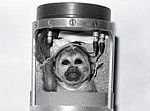
 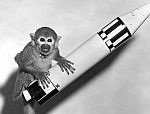 |
Jupiter AM-18 - Bioflight 2
Rhesus monkey Able (top picture) and squirrel monkey Baker (bottom picture) rode in the nose cone of a Jupiter MRBM to an altitude of 483 miles and a over a distance
of 2,400 km. At a top speed of 4.5 km/s, they withstood accelerations of 38 g and were weightless for about nine minutes.
|

June 3, 1959
   |
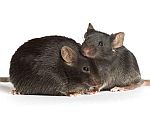 |
Discoverer 3
Four mice on board a surveillance satellite where killed when the upper rocket stage misfired, driving the space vehicle into the Pacific.
It was the only Discoverer mission to carry a biological payload.
|

July 2, 1959
 Otvazhnaya Snezhinka Marfusha   |
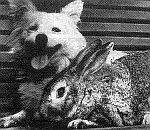 |
R-2A No. 23
An R-2 rocket launched from Kapustin Yar, U.S.S.R. carried dogs Otvazhnaya (picture) and Snezhinka and the first space rabbit, Marfushka (picture) to an altitude of 220 km. |

July 10, 1959
   |
 |
Thor-Able Re-entry 2
A Thor-Able ICBM took mouse Lasker on a ballistic trajectory to a record altitude of 1,600 km and over a distance of 6,000 km. The mouse survived
60G launch acceleration and 45 minutes of weightlessness but the recovery team failed to locate the returned nose cone in the ocean. After two day of search,
Lasker was declared "lost at sea.".
|

July 10, 1959
 Otvazhnaya & Zemchuznaya   |
 |
R-2A No. 24
An R-2 rocket launched from Kapustin Yar, U.S.S.R. carried dogs Otvazhnaya and Zemchuznaya to an altitude of 100 km.
|

July 23, 1959
   |
 |
Thor-Able Re-entry 3
A Thor-Able ICBM took mouse Wilkie on a ballistic trajectory to an altitude of 1,600 km and over a distance of 6,000 km. Again, the recovery team
failed to locate the returned nose cone in the ocean and
Wilkie was declared "lost at sea" two days later.
|

September 15, 1959
   |
 |
Jupiter AM-21 - Bioflight 3
Fourteen mice, along with other biological specimens were killed when a Jupiter IRBM rocket exploded 13 seconds after launch.
|

December 4, 1959
 Sam   |
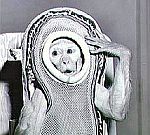 |
Little Joe 2 In a test of the Mercury space capsule, rhesus monkey Sam reached an altitude of 85 km and was recovered safely. |

January 21, 1960
 Miss Sam   |
 |
Little Joe 1B In a test of the Mercury space capsule, rhesus monkey Miss Sam reached an altitude of 14 km and was recovered safely. |

June 15, 1960
 Otvazhnaya & Malek Zvezdochka   |
 |
R-2A No. 27
An R-2 rocket launched from Kapustin Yar, U.S.S.R. carried dogs Otvazhnaya and Malek together with rabbit Zvezdochka to an altitude of 212 km. |

June 23, 1960
 Otvazhnaya & Zemchuznaya   |
 |
R-2A No. 28
An R-2 rocket launched from Kapustin Yar, U.S.S.R. carried dogs Otvazhnaya and Zemchuznaya on their third flight together to an altitude of 212 km.
|

July 28, 1960
   |
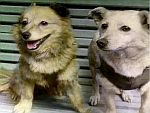 |
Korabl-Sputnik (2)
In the first attempted flight of the Vostok 1K manned spacecraft prototype, the rocket exploded on the launch pad. Dogs Chaika and Lisichka perished in the explosion of the rocket. |

August 12, 1960
 Ham   |
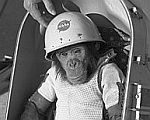 |
Mercury-Redstone 2
In a test of the Mercury space capsule, Chimpanzee Ham became the first hominid in space, performing a successful ballistic flight, reaching an altitude of 253 kilometers. |

August 20, 1960
 Belka & Strelka Rabbit, Rats and Mice   |
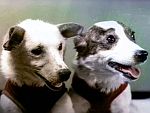
  |
Korabl-Sputnik 2
On August 19, the Soviet spacecraft took two dogs, Belka and Strelka, a gray rabbit, 40 mice, 2 rats, and 15 flasks of fruit flies
and plants to orbit and returned them safely a day later.
|

September 16, 1960
 Palma II & Malek   |
 |
R-2A No. 33
An R-2 rocket launched from Kapustin Yar, U.S.S.R. carried dogs Palma II and Malek to an altitude of 210 km.
|

September 22, 1960
 Otvazhnaya & Neva   |
 |
R-2A No. 34
An R-2 rocket launched from Kapustin Yar, U.S.S.R. carried dogs Otvazhnaya and Neva to an altitude of 210 km.
|

October 13, 1960
 Sally, Amy & Moe   |
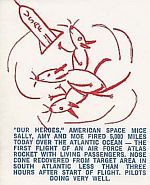 |
Atlas D Research and development test # 29
An Atlas D ICBM, carrying three black mice – Sally, Amy and Moe – in its nose cone was launched from Cape Canaveral and reached an altitude of 1,046 km
to investigate the effect of radiation from the Van Allen belts on living beings. It was the furthest any animals had been into space at that point.
|

December 1, 1960
   |
 |
Korabl-Sputnik 3
Dogs Pchyolka and Mushka and "other animals, plants and insects" performed a one day-long orbital flight. The space craft was destroyed by a self-destruct
mechanism when it overshoot its landing site and was going to land in foreign territory.
|

December 22, 1960
 Zhulka & Zhemchuzhnaya   |

  |
Korabl-Sputnik (4)
Intended as an orbital flight, the spaceship re-entered the atmosphere after reaching a sub-orbital apogee of 214 km due to an upper-stage rocket
failure.
|

February 22, 1961
 Hector   |
 |
Veronique Life Science mission 1
Less than two months before the first manned space flight, France became the third nation to send an animal beyond the 100 km boundary of space. On
board a Véronique rocket launched from Hammaguira, Algeria, rat Hector reached
an altitude of 152 km on a ballistic trajectory.
|

March 9, 1961
 Chernushka Mice, Frogs Guinea Pig   |
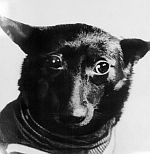
|
Korabl-Sputnik 4
In a rehersal for the flight of Vostok 1, Dog Chernushka, acompanied by some mice, frogs and
(most likely for the first time) a guinea pig performed one orbit before being safely recovered.
|

March 25, 1961
 Zvezdochka   |
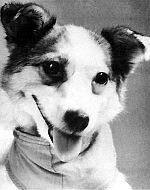 |
Korabl-Sputnik 5
In the last animal experiment before the manned Vostok 1 flight, Dog Zvezdochka performed one orbit before being safely recovered.
|

April 10, 1961
 Two white mice   |
 |
Meteor RM-2C and RM-2D
 During tests of the Meteor sounding rocket, a biological experiment was carried out with two previously trained white mice. The mice were tested to withstand an acceleration of 20 g. On April 10, 1961, two rockets were launched 45 minutes apart, reaching an altitude of 1580 meters. The mice were recovered unharmed. |


| Click here to move on to part 3. |


|
Back to Space Page |
Back to English Main Page |
 Back to Start Page |